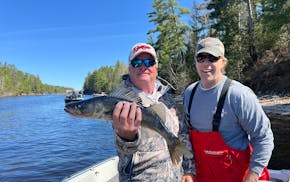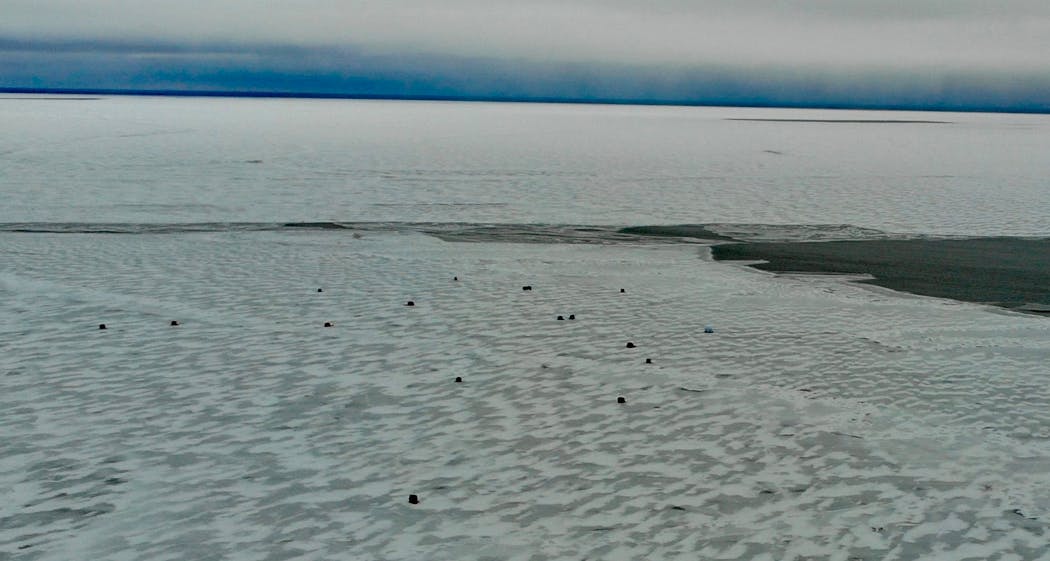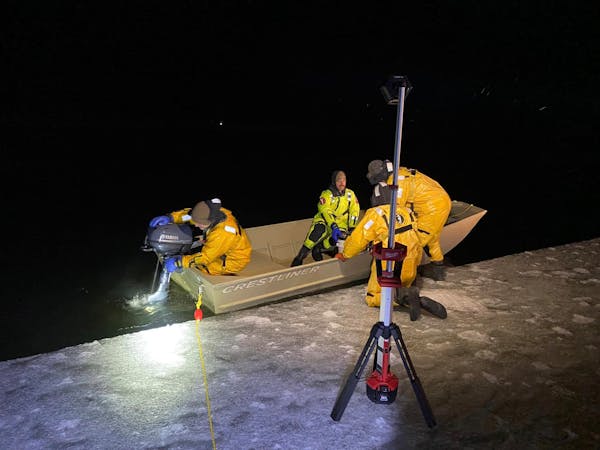When a 30-foot gap of water opened last week between shoreland ice and the ice where about 120 Upper Red Lake anglers were fishing, Beltrami County Sheriff Jason Riggs knew a decision had to be made.
This would be the seventh rescue of ice anglers on Upper Red in about 30 days, and something, the sheriff knew, had to give.
"We deal with [ice rescues] on an annual basis," Riggs said the other day. "It starts about Thanksgiving and usually runs through mid-December. But this winter has been different."
Temperate weather so far has made travel on lakes in southern, central and even northern Minnesota problematic and at times dangerous for ice anglers.
One angler died on Lake of the Woods last week when the track-and-ski commercial transport vehicle he was riding in broke through the ice. Weak ice also claimed the life of a 67-year-old man who drowned during a fishing outing a few days before Christmas in Becker County.
Upper Red is unique among Minnesota lakes because it offers early winter fishing opportunities many anglers can't resist. Its bountiful walleyes seem particularly willing to gobble anglers' baits beginning in late November, and the hot bite usually extends through December and oftentimes beyond.
But the lake's size and the area's frequent winds can combine with uneven temperatures to create ice fissures in the days and weeks before solid ice is achieved. Workarounds by knowledgeable resort owners who monitor the lake's ice depth typically keep anglers safe during this transition period.
But last Friday evening, just as dark descended over 120,000-acre Upper Red, a 30-foot watery swath opened, preventing the 120 anglers from returning to shore.
Some anglers probably didn't know of their predicament until Riggs' office issued an emergency alert that rang on their cellphones, warning them of the danger. Their rescue took about 2½ hours.
Complicating travel on Upper Red this winter has been the region's lack of snow, which has allowed anglers to travel by ATV and snowmobile to areas of unsafe ice.
"People are going wherever they want on the lake because there's no snow," Riggs said. "And they're finding areas of open water."
Last Friday's rescue prompted the sheriff to close Upper Red to vehicle traffic, even though he knew resorts and other businesses around the lake would suffer financially.
The sheriff was correct, said Kevin Waldo, who with his brother, Scott, owns West Wind Resort on Upper Red.
"Before the sheriff issued his order, our business was probably down 50 percent this winter due to the ice situation," Waldo said. "After the order, it's down 80 percent or 90 percent. We're still open because we have employees who count on us at this time of year. But it's pretty quiet around here."
Waldo said Upper Red near his resort is covered with "12 inches of good ice out 3 or 4 miles" from shore. Until the lake is open again to vehicle traffic, the sheriff's department, Waldo said, is allowing resorts to shuttle anglers onto the lake in ATVs to day-fish, which his resort will do this weekend.
Though the Beltrami County sheriff has authority over travel on the lake, rescues on Upper Red typically are undertaken by the fire department of nearby Kelliher, Minn., and the Department of Natural Resources.
Kelliher's population is fewer than 300, and its fire department is staffed by about 20 volunteers, including Waldo.
"We just purchased a small johnboat with an outboard we can drag onto the ice and use to cross any open water to get people back to shore," Waldo said. "And the DNR uses its airboat."
One problem during rescues, Riggs said, is that anglers typically have quite a bit of fishing equipment on the ice they want to bring with them to shore.
"But when you're talking about people's lives, that has to be the priority, not the property," he said. "So at times we're leaving 40, 50 or 60 four-wheelers on the ice, which isn't good for the environment or for the people."
Added Waldo, "Some of these guys have 5,000 dollars worth of electronics they want to take with them off the ice."
Typically, resort employees will return to the ice the next day or whenever the open water freezes to gather the gear for return to their owners.
Estimating the financial cost of Upper Red rescues to the sheriff's department, the DNR and the Kelliher Volunteer Fire Department is difficult, Riggs said, adding that each rescue probably runs in the neighborhood of $6,000 to $10,000.
Three of his deputies might be assigned to a given rescue, the sheriff said.
"If they weren't doing that, they would be responding to crimes, medicals or 911 calls," he said. "That's what we're pulled away from. But the fire guys, if they have a house fire while they're on a rescue, that's something else."
The Sheriff's Department, resort owners, the DNR, local tribal authorities and others are monitoring Upper Red ice to determine when the lake can be reopened to vehicle travel.
That day likely will be sooner than later, given that high temperatures in the area the next 10 days are forecast to be 29 degrees or lower and daily low temperatures from 8 degrees to minus-2.
Anglers are advised to check the websites and Facebook pages of local resorts and the Beltrami County Sheriff's Office for ice conditions and regulation changes.

Anderson: In early June, Minnesota fish are begging to be caught. Won't you help?

Anderson: Tails wagging, DNR officers' dogs find lost people and missing evidence
Anderson: Punish poachers more
Anderson: The Chainsaw Sisters Saloon is gone, but the Echo Trail is still a pathway to possibilities




